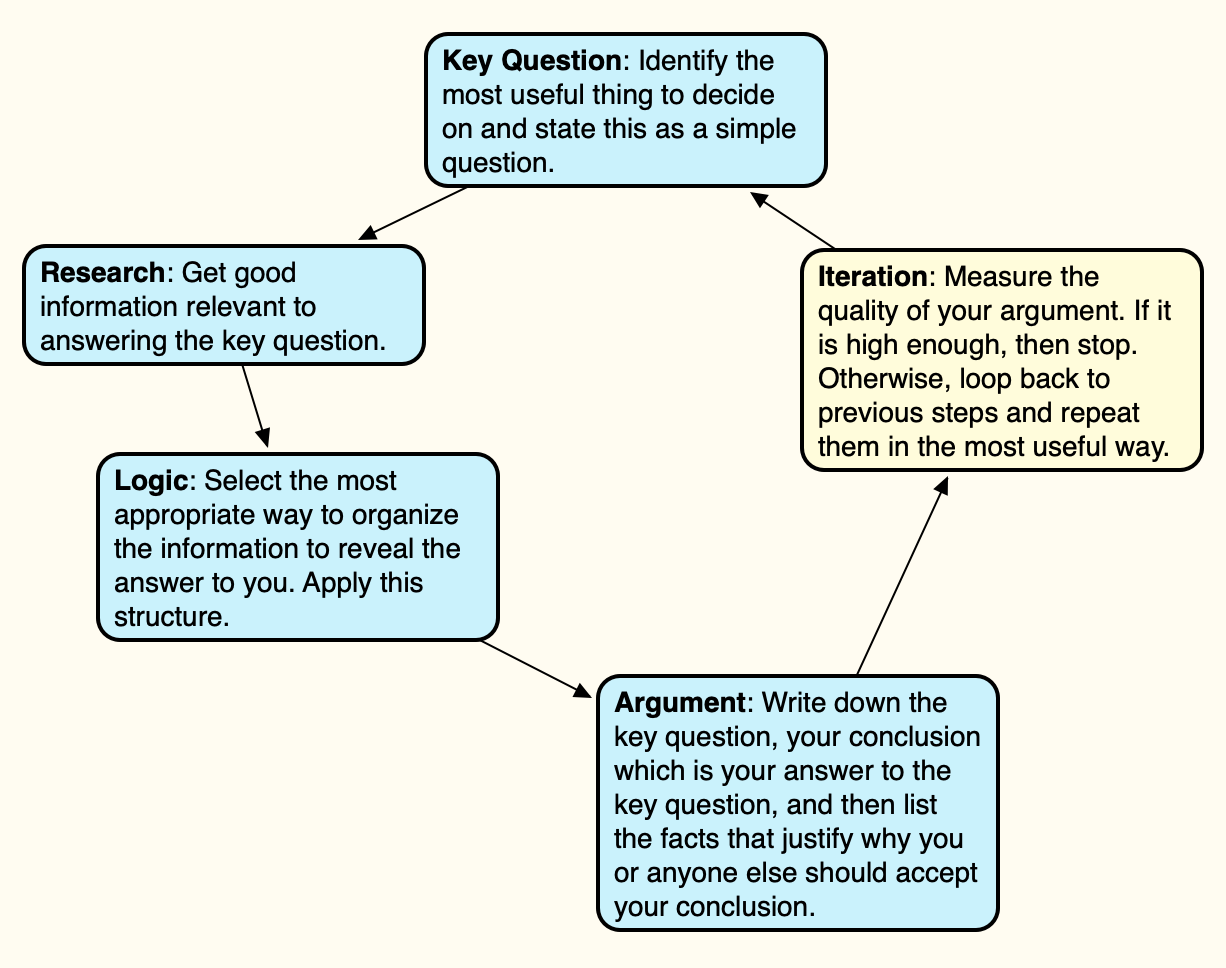How to Apply Critical Thinking
- id: 1688123433
- Date: Nov. 9, 2024, 11:28 a.m.
- Author: Donald F. Elger
Background
The purpose of critical thinking (CT) is to make the best decision (find truth). This note explains how to do this.
The first action is to make it your purpose to figure out what true or what is the best action to take. I do not list this as a “action” because it is more like making a life choice. This choice is the most important element of critical thinking.
The CT Method: Five Actions
When you or your group are in the role of “decision maker,” then make decisions using the five actions that are summarized in Figure 1.
 Figure 1. CT
involves five intertwined actions that are usuually done
iteratively.
Figure 1. CT
involves five intertwined actions that are usuually done
iteratively.
![[ct-map.scap]]
When you or your group are in the role of “audience”, then you examine a decision made by
1. Key Question
Identify the single most important topic to make a decision about.
Then, frame this topic using a simple question that is called the “key question.”
Write this question down so there is no ambiguity about what the focus of the decision making is on.
This next list gives some examples of key questions:
What are the best actions I can take today?
What is the best way to learn to play the cello?
What are best ideas for improving our marketing and sales?
How can we make our meetings better?
Is it true that the 2020 presidential elections was stolen?
Why is their so much divisiveness in our country?
Should we buy a new microwave?
2. Research
To research means to get information about a topic. There are three general ways to do research: secondary research, primary research, and internal research.
In the CT method, research involves getting good information for answering your key question.
Good information is defined by seven criteria: useful, true, accurate, complete, well-organized, easy-to-understand, and justified.
For doing research, I recommend the method called “effective research” which is explained in The Research BookCourse.
3. Logic
Logic refers to organizing facts in a way that maximizes the probability of choosing the best action to take or figuring out what is true and what is not true.
Logic involves a logic structure, which is a way of organizing facts. There are many different logic structures that have been found to be useful.
The way to apply logic is as follows.
Select the logic structure that is most appropriate for your key question and context.
Apply this structure to the current key question using the facts that you uncovered in your research.
4. Argument
In CT nomenclature, an argument refers to a claim or conclusion plus one or more reasons that justify why the claim or conclusion should be justified.
The way to make an argument is to write down the follows
Summarize the key question.
State your conclusion, which is the answer to the key question.
Justify your claim by using facts that are organized with the logic structure you selected.
Here is an example of a argument:
Key Question: What is the best way to train for fitness on a bicycle?
Claim: The best way to train is to use polarized training plus periodization that is individualized to you.
Reasoning. The reasons why I make this claim are as follows.
There is strong evidence for this in the research literature; see the Dylan Johnson’s videos on YouTube for explanations and links to research paper.
This is the structure used by professionals.
When I have followed this approach, it has worked for me far better than anything else I’ve tried.
There are many other ideas that are helpful: healthy diet, visualization, bike setup, and so forth. Apply all of these also, but the big changes are going to be driven by polarized training and periodization.
Note: There are many ways that I can improve the quality of this argument, but my purpose is to illustrate the structure of an argument.
5. Iteration
Iteration is a method for getting something to have good, excellent, or awesome quality. This method involves doing something over and over and over while concurrently improving quality with each cycle.
In the context of CT, iteration involves doing this set of actions {key question, research, logic, argument} over and over until the quality of the argument is good enough for your context and audience.
The reason why iteration is so useful is that coming up with a good argument is hard and trying to do this in one step often does not work.